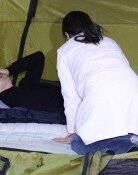Military Criticized for `Lukewarm Response` to Artillery Firing
Military Criticized for `Lukewarm Response` to Artillery Firing
Posted August. 12, 2010 08:41,
Public anger is rising over the South Korean militarys lukewarm response to North Koreas artillery firing Monday.
The Defense Ministry initially said Monday that the coastal artillery shells fired by the North did not land south of the western inter-Korean sea border but reversed its stance a day later.
On criticism over its late response when artillery shells landed in waters one to two kilometers south of the border, the ministry said Tuesday that it gave a proper response in delivering three warning signals in line with combat rules.
Seoul said its warnings prompted Pyongyang to stop firing toward the inter-Korean maritime border near Bangnyeong Island.
The North, however, reportedly continued firing despite the warnings. Some 10 artillery shells were launched south of the border off Bangnyeong Monday from 5 p.m. to 5:33 p.m. Roughly 100 additional rounds were fired toward waters north of the border around Yeonpyeong Island after 5:52 p.m.
One or two shells landed in South Korean waters.
Seouls first warning was sent at 5:53 p.m., or 23 minutes after the first artillery firing, and the second came after shells were launched toward waters off Yeonpyeong.
The South Korean Joint Chiefs of Staff said the warnings prompted the North to stop firing, saying, Our first communication warning was against artillery firing toward Bangnyeong Island, not Yeonpyeong Island. The firing stopped after our warning.
Critics say the governments explanation is hardly reasonable, however. A South military source said, Communication warnings through wireless communication lines of international ships were issued against North Koreas artillery shell firing overall, not just certain shots. The militarys explanation that the artillery firing toward Bangnyeong Island stopped after the first warning makes no sense. If the warning was effective, the North shouldn`t have fired toward Yeonpyeong Island.
Seoul issued its second warning at 6:04 p.m. Monday but Pyongyang fired around 100 more shells on a time-on-target basis. The firing stopped only after the final warning was issued 10 minutes later.
Considering these situations, the warnings apparently failed to work and additional responses seemed necessary since the landing of the shells in South Korean waters violated the 1953 armistice treaty.
In January this year, South Korea had threatened to directly fire back if North Korea fired at South Korean waters, but did not make good on its pledge this time.
A Joint Chiefs of Staff source in Seoul said without giving details, Combat rules vary according to whether the shells land in waters south of the inter-Korean border or on land or damage a ship. We observed combat rules.
polaris@donga.com



![[단독]임성근, 4차례 음주운전 적발…99년 집행유예 기간 중 무면허 음주 적발](https://dimg.donga.com/c/138/175/90/1/wps/NEWS/IMAGE/2026/01/20/133195400.1.png)

![“한동훈, 정치생명 걸고 무소속 출마해 평가받는 것 고려할만”[정치를 부탁해]](https://dimg.donga.com/c/138/175/90/1/wps/NEWS/IMAGE/2026/01/19/133186982.1.jpg)

